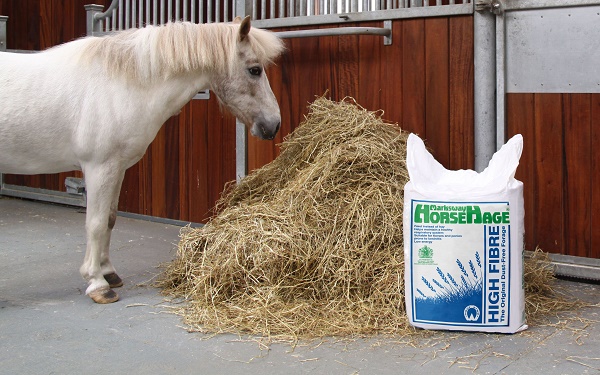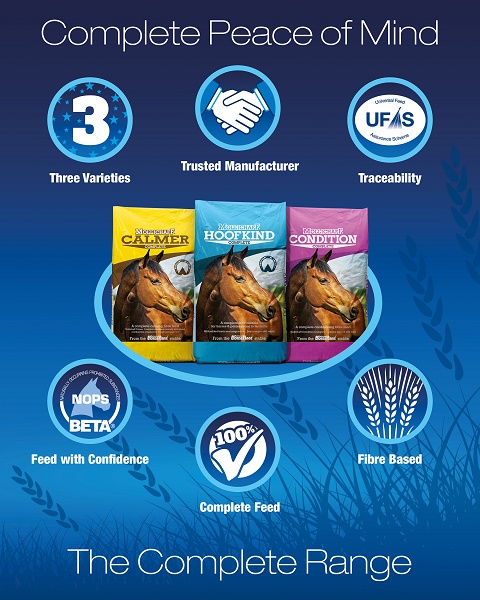Posted: 12th July 2021 | Back to news feed

In this article we are talking all about fibre in your horse’s diet. This can be provided by the horse’s natural grazing, forage, chaff or high fibre feeds. Here are five facts on the importance of fibre from HorseHage and Mollichaff:

1) Feed fibre first.
The horse, through evolutionary adaptation which has occurred over a period of 65 million years, has become a ‘trickle-feeder’. His digestive system, with its small stomach and very large bacteria-filled hind gut is designed to contend with an almost continuous supply of grass and herbage. Food is moved along the digestive tract by muscular contractions or waves known as peristalsis. The gut is designed to receive a small but regular and frequent supply of food (trickle feeding) to encourage these ‘waves’ to continue. A period of as little as eight hours without food may cause a slowing of these muscular contractions and impair the digestive process. A high fibre diet is a more natural way to feed you horse compared to a high cereal diet and forage can provide 70-100% of the diet. (If 100% of the diet is provided by forage, a broad spectrum vitamin or mineral source such as a good quality balancer should also be provided.)
2) Fibre – It’s not just a filler!
Many horse owners feed a small amount of chaff just to bulk out the concentrate feed but there are other beneficial reasons for its use. Horses are predominantly fibre digesters or hindgut fermenters. Within the hindgut, are millions of micro-organisms that play a vital role in breaking down the digestible fibre content of the natural herbage diet, releasing energy-giving substances which the horse then uses.
Contrary to some beliefs, fibre is not just a ‘filler’, as the hindgut micro-organisms create a delicate microbalance which, if upset, may result in health and performance problems and also may suppress the immune status of the horse, often creating a downward spiral of health problems.
3) Fibre can help buffer stomach acid
Trickle feeding fibre such as chaff (a little at a time) encourages horses to chew, producing much more saliva than when concentrates are fed on their own and this alkaline saliva buffers the stomach acid. The presence of a high fibre feed such as chaff in the stomach helps to neutralise stomach acid. Chaff will also encourage chewing, prolonging feeding time and the production of increased amounts of acid-buffering saliva. Furthermore, alfalfa may actually have a more protective effect than other hay-based chaffs because of the high protein and calcium content giving improved buffering properties. Feeding a bowl of alfalfa chaff or any chaff prior to exercise may be helpful as this will help to reduce the splashing effect of acid on an empty stomach.
4) Fibre can reduce boredom for stabled horses
Feeding a chaff will stimulate the production of saliva and will satisfy a stabled horse’s psychological need to chew, as a product such as Mollichaff can require up to 8000 chews per kilo to eat compared to as few as 1200 for concentrates. By providing plenty of fibre to horses that have to spend increased periods of time stabled can prolong eating time and decrease the likelihood of stereotypical behaviour caused by stress and/or boredom.
5) Fibre – fuelling the horse’s central-heating system
During cold weather, access to fibre has a double advantage as not only does it keep the digestive system functioning correctly, but additionally, the digestion of fibre in the hind gut creates heat as a by-product, quite literally warming your horse up from the inside out! The digestion of fibre in the horse’s system produces heat so it is also a vital tool to keep them warm, particularly if they live out or are not rugged.

For more information please call the HorseHage Helpline on 01803 527274 or visit www.horsehage.co.uk
The Equestrian Index newsfeed is compiled from articles submitted by advertising members and expresses the opinions of those members. Watsons Directories Ltd shall not be held liable for any inaccuracies or mis-statements therein.